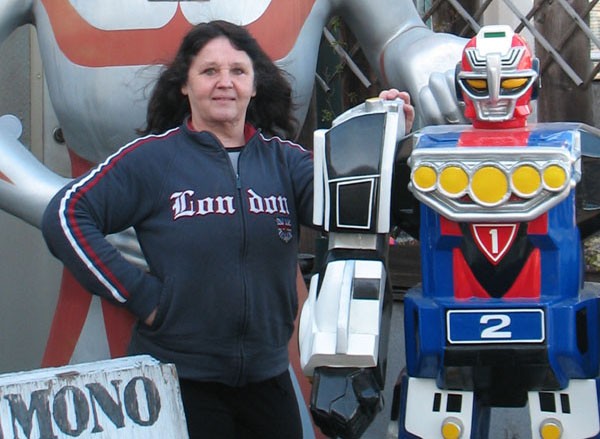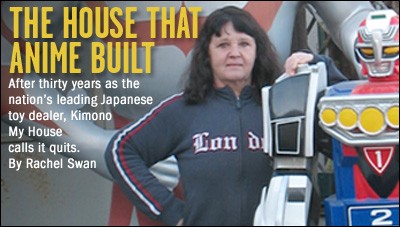One of the world’s largest collections of Japanese sci-fi and anime toys sits above a warehouse in Emeryville, in a tiny storefront that began life as a kimono shop. Called Kimono My House, the place has no distinguishing features, but for the Ultraman and Transformer statues guarding its door. Inside, it’s a veritable fantasy world: The shelves brim with Robotech action figures, Totoro stuffies, Sailor Moon dolls, monster model kits, tin litho windups, Valkyrie aircrafts, Pokemon windup toys, Power Rangers, posters, T-shirts, comic books, and Godzillas. Now thirty years old, the place has an international reputation and small cult following. At one time it was the sole purveyor of anime merchandise in the United States, and held a virtual monopoly over the rarefied Japanese toy market. But when anime began going mainstream, Kimono My House became obsolete. This month the store will shut its doors and pack up its last robots.
“It’s really sad,” said Susan Horn, a former hippie and art student who first leased the store as live-work space in 1980, and became the nation’s leading anime toy dealer almost by accident. Now 57, Horn wipes tears from her eyes as she peruses the shelves of her store, which looks more like a mausoleum than a retail store. At the counter she picks up an 8×11-inch paper with a drawing of the store by longtime customer Tennessee Myers. Addressed to Horn’s business partner and ex-boyfriend, Yuki Yoshimura, the picture showed the shuttered storefront under two unhappy rainclouds, and a large Godzilla on its roof. At its left stands the Ultraman statue with a large speech bubble: “I was programmed to watch over this place. Argh.”
Horn opened the store with a small inventory of Japanese kimonos and textiles amassed from the two years she spent teaching English in Japan after getting rejected from an MFA program at UC Berkeley. At the time she had no long-term business plan, since “long-term” wasn’t part of her personality. In 1971, she hitchhiked to California from her hometown in New Jersey, matriculated in the art department at Cal, and stuck with it through the first phase of graduate school. She traveled to Japan in her late twenties, learned the language, and became an enthusiast for the culture. Upon returning home, she opted for a career that would require her to fly back to Japan every few years to haggle with antique dealers and manufacturers.
At a time when Emeryville was completely devoid of retail, Horn opened Kimono My House with a small inventory of kimonos. She sustained her business by word of mouth, gathering special orders from customers and taking them back to Japan. In 1981 she recruited Yoshimura, who had been running a tea ceremony business on Telegraph Avenue but saw more potential in kimono retail. Then, in 1984, someone came in asking about the new Takatoku Macross Valkyrie, a robot that transformed into a jet. Horn had never heard of the toy but went hunting for it on her next trip to Japan, and returned with an armload. Within five years she overhauled her original business, and become the first exclusive anime toy dealer in the country. The Valkyries would quickly be joined by Project A-Ko dolls, Speed Racers, and Nausicaä pencil cases. Her kimonos ended up in storage.
Although Kimono My House had no visible storefront, it became legendary among a core group of collectors. The prototype would be someone like 29-year-old Kenny Argo, who bought his first Japanese toys from a San Francisco shop about the size of a walk-in closet that neighbored the Honda dealership where his dad used to work. “Growing up in the ’80s you recognize things later in when you start collecting,” said Argo, who spent the last week at Kimono My House helping Horn box toys and put them in a nearby warehouse. “One thing leads to another, then the next thing you know you’re spending $500 on a robot.” (Argo said he maxed out at $400, but apparently, “that’s nothing.”) He stumbled upon Kimono My House at the WonderCon comic book convention roughly twelve years ago, and fell in love. He began spending every weekend at the little shop. “My wife calls it my second home,” he said.
Argo, who now lives in Concord and runs his own online toy business — a mix of Japanese and domestic merchandise — has the old-school collector profile for which Kimono My House was best suited. He’s a purist who favors authenticity over affordability, and would readily pay more for a Japanese import than a cheaper American knockoff. Horn said that kids with Argo’s sensibility began emerging in the 1980s, when Japanese anime first began percolating into American popular culture, but still was alternative to the mainstream.
“There was probably this Golden Age of collecting and appreciation for the characters,” said Horn. “When Japanese animation came here — the Power Rangers and stuff — there was a lot of fighting and drama. What kids saw on American cartoons were like the Care Bears. Everything was feel-good and soft. The Japanese stuff had action, characters, and stories.” She cites examples of Japanese cartoons with elaborate storylines. Astro Boy was a robot surrogate for the son of Dr. Tenma, who had died in a car accident. Kiki’s Delivery Service was a cartoon about a witch who finishes her apprenticeship and goes off to the big city — it’s really a parable about becoming an adult.
But more important than the collector clientele was the fact that bigger companies hadn’t quite latched onto the anime niche market. “When we were the only ones doing this it was always crowded,” said Horn. “There was always a lot of interest, and people would come from really far. It would be like a pilgrimage. Everyone would jump in a car from LA and come all the way up here to see our new stuff.”
Then, in the mid- to late-’80s, American chains like Toys ‘R Us began cannibalizing Horn’s business, licensing from companies in Japan to mass-produce things that weren’t as nice as the originals, she said, but were a lot cheaper nonetheless. The Japanese versions were more detailed and interesting, said Horn; the American knockoffs were tawdry and simplified. But as anime gradually became more and more ubiquitous — to the point that you can now buy Hello Kitty Snowboards or mail-order any Japanese item with a few clicks of your mouse — Kimono My House became more and more anachronistic. Die-hard customers like Argo grew up and built their own toy businesses, and ultimately became competitors. There was no way for a small rooftop toy store to survive.
“Now a lot of times we’ll sit here and nobody comes in,” said Horn. “Yuki will sit here on a Sunday and he might have one person come in, they just look around and they don’t buy anything. It’s hard, you know? You just don’t want to sit here all day and have a couple people just wander in, look around, and leave.” A couple weeks ago when the store’s lease once again came up for renewal, Horn and Yoshimura decided they didn’t have the heart to do it any more. They plan to remain open on weekends until the end of February, and then move Kimono My House online, just like everyone else. Horn will devote herself full-time to Emeryville Taiko, the nonprofit taiko drum group she launched roughly a decade ago. She plans to live modestly and continue indulging in Japanese culture, albeit without any business incentive. Horn says that losing the toy enterprise won’t put her in a rut financially, since she hasn’t seen any real income for the last ten years anyway.
But the store’s death won’t go by unnoticed. Horn said that when Kimono My House held a good-bye party a couple weeks ago, the place was packed again, and people came from as far away as Seattle and New York to pay homage. Argo will remain nostalgic for a long time. “It’s definitely a one-of-a-kind institution — the last of its kind really,” he said. “I don’t know what I’ll do with all my free time now if I’m not just hanging around the shop.”














